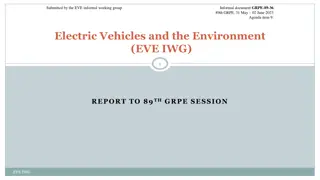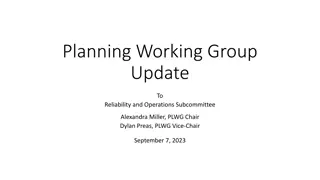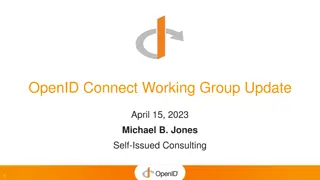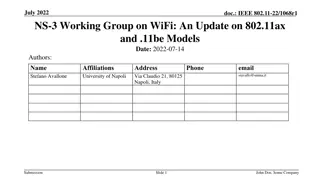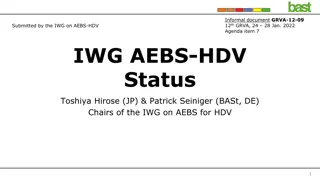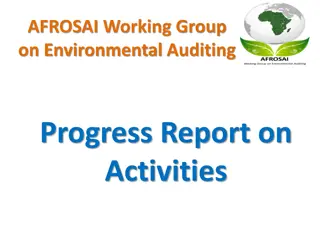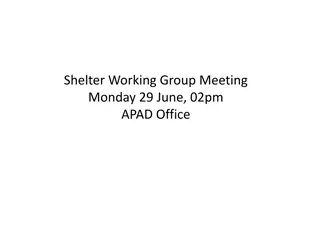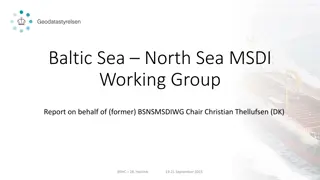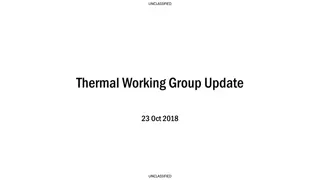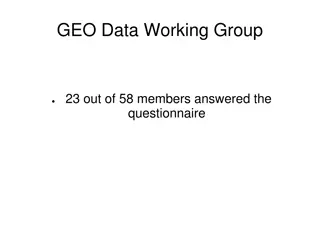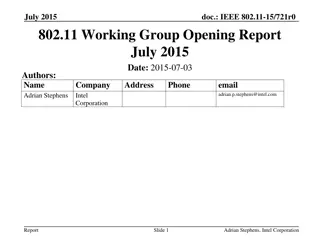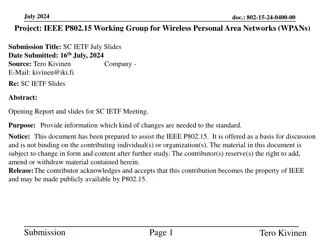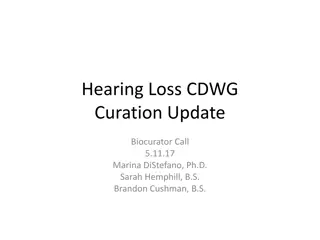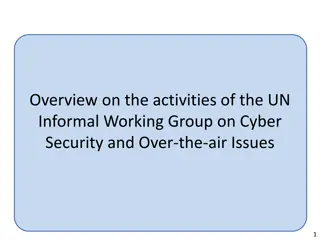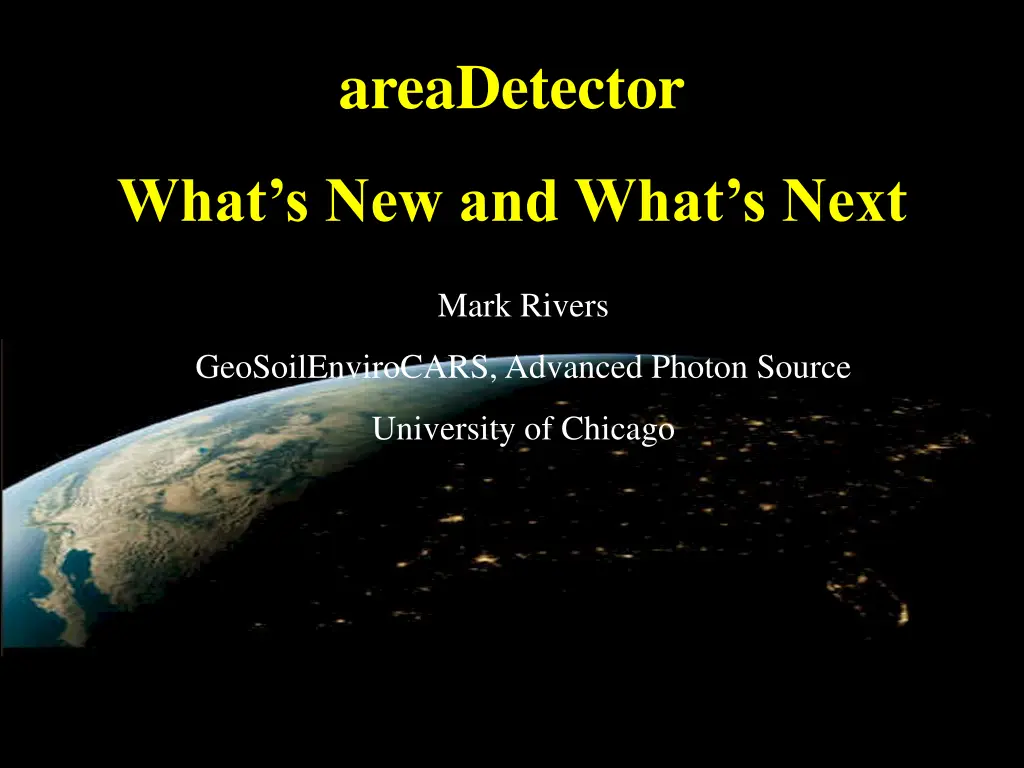
New Features and Updates in areaDetector Software
Discover the latest advancements in areaDetector software by Mark Rivers at GeoSoilEnviroCARS, University of Chicago. Explore the updates since October 2017, including releases R3-2 and R3-3, with a glimpse into future developments in R4-0 and R5-0. Learn about EPICS_NTNDA_Viewer, NDPluginDriver enhancements, NDPluginScatter updates, and NDArrayPool design improvements for efficient image processing.
Download Presentation

Please find below an Image/Link to download the presentation.
The content on the website is provided AS IS for your information and personal use only. It may not be sold, licensed, or shared on other websites without obtaining consent from the author. If you encounter any issues during the download, it is possible that the publisher has removed the file from their server.
You are allowed to download the files provided on this website for personal or commercial use, subject to the condition that they are used lawfully. All files are the property of their respective owners.
The content on the website is provided AS IS for your information and personal use only. It may not be sold, licensed, or shared on other websites without obtaining consent from the author.
E N D
Presentation Transcript
areaDetector What s New and What s Next Mark Rivers GeoSoilEnviroCARS, Advanced Photon Source University of Chicago
Outline Last update was October 2017 at ITER and ICALEPCS in Barcelona areaDetector and ADCore Releases since then: R3-2, R3-3 (soon) Brief recap of the top items from R3-0 for those who missed it Major new features in 3-2 and 3-3 Roadmap for R4-0 and R5-0
EPICS_NTNDA_Viewer ImageJ plugin (ADViewers R1-0) New ImageJ plugin written by Tim Madden and Marty Kraimer Essentially identical to EPICS_AD_Viewer.java except that it displays NTNDArrays from the NDPluginPva plugin, i.e. using pvAccess to transport the images rather than NDPluginStdArrays which uses Channel Access.
EPICS_NTNDA_Viewer Advantages NTNDArray data transmitted "atomically" over the network With Channel Access size and data type of waveform record is fixed at iocInit, cannot be changed at runtime. To view both 8-bit and 64-bit double FFT images waveform record needs to be 64-bit double, 8X network overhead for 8-bit. pvAccess changes the data type of the NTNDArrays dynamically at run-time. Channel Access requires setting EPICS_CA_MAX_ARRAY_BYTES, considerable confusion and frustration for users. NDPluginPva is 5X-10X faster than NDPluginStdArrays ImageJ is 1.5-2X faster with pvAccess than with Channel Access.
NDPluginDriver (R3-0) Multiple Threads per Plugin Added support for multiple threads running the processCallbacks() function in a single plugin. Can improve the performance of the plugin by a large factor. Linear scaling with up to 5 threads (the largest value tested) observed for most of the plugins that now support multiple threads. Maximum number of threads that can be used for the plugin is set in constructor and in IOC startup script. Actual number of threads to use controlled via an EPICS PV at run time, up to the maximum value passed to the constructor. Note that plugins need to be modified to be thread- safe for multiple threads running in a single plugin object.
NDPluginScatter + V4 Distribute file writing to multiple IOCs (4096 x 3078 8-bit) IOC #1 IOC #2 IOC #3 IOC #4 ADSimDetector NDPluginScatter NDPluginPva NDPluginPva NDPluginPva pvaDriver pvaDriver pvaDriver NDFileHDF5 NDFileHDF5 NDFileHDF5 # IOCs 1 2 3 Files/sec 101.0 195.2 217.5 GB/sec 1.19 2.29 2.55
NDArrayPool Design Enhancements (R3-3) Previously each plugin used its own NDArrayPool. Problem: not really possible to enforce the maxMemory limits for the driver and plugin chain. Sum of the memory use by the driver and all plugins that matters, not the use by each individual driver and plugin. NDPluginDriver base class changed to set its pNDArrayPool pointer to the address passed to it in the NDArray.pNDArrayPool for the NDArray in the callback. Ultimately all NDArrays are derived from the driver, either directly, or via the NDArrayPool.copy() or NDArrayPool.convert() methods. Thus plugins now allocate NDArrays from the driver's NDArrayPool, not their own.
NDArrayPool Design Enhancements maxMemory argument to the driver constuctor now controls the total amount of memory that can be allocated for the driver and all downstream plugins. maxBuffers argument to all driver and plugin constructors is now ignored. Now no limit on the number of NDArrays, only on the total amount of memory. maxBuffers argument to the ADDriver and NDPluginDriver base class constructors are still present so existing drivers and plugins will work with no changes. This argument is simply ignored. maxMemory argument to the NDPluginDriver constructor is only used for NDArrays allocated before the first callback, so it can safely be set to 0 (unlimited). These changes are generally backwards compatible. However, startup scripts that set a non-zero value for maxMemory in the driver may need to increase this value because all NDArrays are now allocated from this NDArrayPool.
Active Plugin Counting and Waiting for Plugins to Complete (R3-3) Previously to wait for plugins to complete before the driver indicated that acquisition was complete then needed to set CallbacksBlock=Yes for each plugin in the chain. Waiting for plugins is needed in cases like the following Doing a step scan and one of the counters for the step-scan is a PV from the statistics plugin. Necessary to wait for the statistics plugin to complete to be sure the PV value is for current NDArray and not the previous one. Doing a scan and writing the NDArrays to a file with one of the file plugins. N Necessary to wait for the file plugin to complete before changing the file name for the next point. Problems with setting CallbacksBlock=Yes. Slows down the driver because the plugin is executing in the driver thread and not in its own thread. Complicated to change all of the required plugin settings from CallbacksBlock=No to CallbacksBlock=Yes.
Active Plugin Counting and Waiting for Plugins to Complete NDPluginDriver base class now does the following: Increments a NumActivePlugins counter in the driver that owns each NDArray as it is queued Decrements the counter after the processing is done. All drivers have 3 new records: NumActivePlugins: Indicates the total number of NDArrays that are currently processing or are queued for processing by this driver. WaitForPlugins: Determines whether AcquireBusy waits for NumActivePlugins to go to 0 before changing to 0 when acquisition completes. AcquireBusy: busy record that is set to 1 when Acquire changes to 1. It changes back to 0 when acquisition completes, i.e. when Acquire_RBV=0. If WaitForPlugins is Yes then it also waits for NumActivePlugins to go to 0 before changing to 0. Should now rarely be necessary to change plugins to use CallbacksBlock=Yes.
NDFileTIFF (R3-3) Added support for readFile() so it is now possible to read a TIFF file into an NDArray using this plugin and do callbacks to downstream plugins. All datatypes (NDDataType_t) are supported. Supports Mono, RGB1, and RGB3 color modes. It also correctly reads files written with RGB2 color mode. Sestores the NDArray fields uniqueID, timeStamp, and epicsTS if they are present. Restores all of the NDArray NDAttributes that were written to the TIFF file. Because of the way the NDAttributes are stored in the TIFF file the restored attributes are all of type NDAttrString, rather than the numeric data types the attributes may have originally used. One motivation is for NDPluginProcess to be able to read TIFF files for the background and flat field images, rather than needing to collect them each time it is used.
NDPluginProcess (R3-3) Load a dedicated TIFF plugin for the NDPluginProcess plugin in commonPlugins.cmd. Used for reading background or flatfield TIFF files. Add an sseq record to load the background image from a TIFF file. Executes all the following steps: 1. Saves the current NDArrayPort fo the Process plugin to a temporary location 2. Sets the NDArrayPort to the TIFF plugin. 3. Enables ArrayCallbacks for the TIFF plugin in case they were disabled. 4. Process the ReadFile record in the TIFF plugin. This reads the TIFF file and does callback to the Process plugin. 5. Loads the NDArray from the callback into the background image. 6. Restores the previous NDArrayPort from the temporary location. Add an sseq record to load the flatfile from a TIFF file. Executes the same steps as for the background above, except that in step 5 it loads the NDArray into the flatfile image.
NDPluginProcess (R3-3) New records
NDFileHDF5 (R3-2) Added support for blosc compression library. Compressors include blosclz, lz4, lz4hc, snappy, zlib, and zstd. Also support for ByteSuffle and BitShuffle. ADSupport now contains the blosc library, so it is available for most architectures. The build flags WITH_BLOSC, BLOSC_EXTERNAL, and BLOSC_LIB have been added, similar to other optional libraries. Thanks to Xiaoqiang Wang for this addition. Changed all output records in NDFileHDF.template to have PINI=YES. This is how other plugins all work.
NDPluginFile Capture Mode (R3-2) Changed the way that capture mode is implemented. Previously it created NumCapture NDArrays using the "new" operator. As NDArrays arrived it copied the data and attributes into these arrays. This had several problems: NDArrays were not allocated from the NDArrayPool, so memory limits were not enforced. Because not allocated from NDArrayPool if passed to other functions or plugins there would be problems with attempts to call NDArray::reserve() or release(). The copy operation is inefficient and not a good idea. Changed to: Allocate an array of NumCapture pointers. As NDArrays arrive their reference count is incremented with reserve(). NDArray address is copied to the pointer array After the files are written the cleanup routine now simply decrements the reference counter with release(), rather than having to delete the NDArray. New scheme is much cleaner. May require some changes to startup scripts to increase NDArrayPool size.
NDPluginOverlay (R3-2) Improved behavior when changing the size of an overlay. Previously the Position was always preserved when the Size was changed. Not the desired behavior when the user had set the Center rather than Position. Code now remembers whether Position or Center was last set, and preserves the appropriate value when the Size is changed. Overlays were previously constrained to fit inside the image on X=0 and Y=0 edges. User may want part of the overlay to be outside the image area. Location of the overlay can now be set anywhere, including negative positions. Each pixel in the overlay is now only added if it is within the image area. Changed the cross overlay so that it is drawn symmetrically with the same number of pixels on each side of the center. Actual size is 2*Size/2 + 1, =Size+1 if Size is even.
Operator displays medm, edm, caQtDM, CSS-BOY (R3-2) Added ADApp/op/Makefile. Runs the conversion tools to convert the medm adl files to edl for edm, ui for caQtDM, and opi for CSS-BOY. RULES_OPI file was added to synApps/support/configure to support this. If RULES_OPI file is not found the Makefile does nothing. If the RULES_OPI file is found then a CONFIG_SITE file in synApps/configure or in EPICS base must define these symbols: ADL2EDL: path to adl2edl for edm ADL2UI: path to adl2ui for caQtDM CSS: path to css. Must be a recent version that supports the command css -nosplash -application org.csstudio.opibuilder.adl2boy.application edl/autoconvert, ui/autoconvert, and opi/autoconvert directories contain new conversions of all of the medm files. edl, ui, and opi directories should contain only manually tweaked files. Many of the files in these directories have been removed, either because they were actually old autoconverted files, or because they are obsolete and the new autoconverted files are better.
medm File Improvements (R3-2, R3-3) Good conversion requires a good medm adl file Text graphics widget sizes are set to the actual size of the text. medm will display text outside the widget if it is not large enough, but other display managers will not. Text update widgets set to the correct datatype. medm will display an enum widget as a string even if the datatype is set to "decimal" rather than "string", but other display managers will not.
medm CSS-BOY
medm caQtDM caQtDM comes with a good adl to ui conversion tool, no changes needed
medm edm adl2edl required changes for parallel make because it used a hardcoded temporary file name (where to push fix?) Quality of conversions is poor. adl2edl needs work.
Other Changes (R3-3) NDArrayPool Enhancements Changes to allow inheriting it from derived classes. Thanks to Sinesa Veseli for this, he will present later this morning. Optimization to memory allocation mechanism. Original work by Michael Huth. I am currently modifying to use std::multiset, same as used for plugin output sorting. ntndArrayConverter.cpp Added conversion of the NDArray.timeStamp and NDArray.epicsTS fields from EPICS epoch (Jan. 1 1990) to Posix epoch (Jan. 1, 1970). Needed because NDArrays use EPICS epoch but pvAccess uses Posix epoch and the timestamps shown by pvGet were incorrect for the NTNDArrays.
Point Grey 10-Gbit Ethernet Camera Oryx ORX-10G-51S5C-C 2448 x 2048 global shutter CMOS Sony IMX250 2/3 Dynamic range of 72 dB Peak QE of 62% Read noise of 2.2e- 12-bit, 10-bit, or 8-bit data Max frame rate of 162 fps 779 MB/S, >8X faster than GigE $1,875
ADSpinnaker New driver for Point Grey GeniCAM cameras using their Spinnaker SDK (10 GigE, GigE, USB-3) Currently working on Windows Linux requires Ubuntu 16 (gcc 5.4, special release of ffmpeg) Some work beginning on aravisGigE driver Guabao Shen at APS and Neil O Brien at Diamond)
ADPixirad Added support for the PIXI-III chip New CountMode record to select Normal, NPI and NPISUM count modes. New HitThreshold record to control the VtHit value.
Roadmap: ADCore R4-0 Put more functionality into ADDriver base class Derived class would call ADDriver::doPluginCallbacks(), which would handle setting attributes, getting timestamp, calling plugins, etc. Simplify file saving modes (no more Single, Capture, Stream) and eliminate AutoSave Add flag to prevent overwriting files
Roadmap: ADCore R5-0 Change NDArray to NTNDArray for passing data to plugins Use PVDatabase local provider within IOC pva provider between IOCs Smart pointers automatically eliminate all unnecessary copying Eliminates need for NDPluginPva V4 clients can immediately receive data from any point in plugin chain Distribute load to multiple IOCs without pvaDriver Bruno Martins has demonstrated this working for ADSimDetector and NDPluginStats

